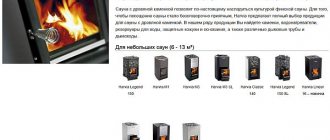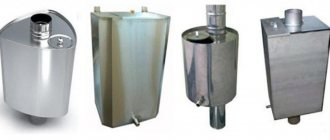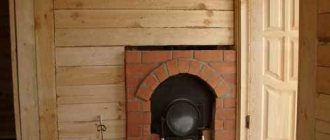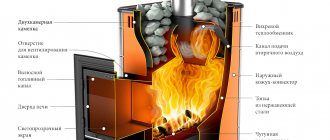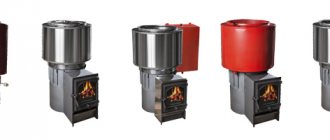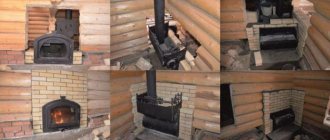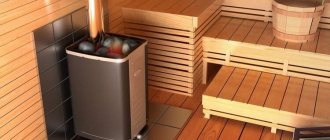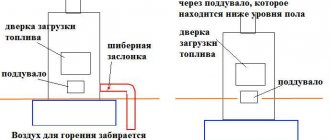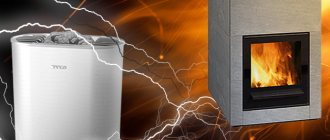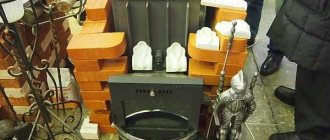The most common stoves in baths and saunas are metal (homemade or factory-made). But metal stoves are different:
- made of steel (black and stainless steel);
- made of cast iron.
Metal stoves made of heat-resistant steel are small in size, quickly heat the room due to excellent thermal conductivity, but they cannot accumulate heat. To eliminate this drawback, they are lined with bricks. Another drawback: steel, although heat-resistant, burns out quickly.
Metal sauna stoves
When heating a ferrous metal stove, do not get carried away. When the walls become red-hot, the process of burning out oxygen begins and active oxidation occurs. A specific taste of rust may even appear in the air (typical of stoves using low-carbon steel).
Materials from which stoves are made
Among fans of steel stoves, there is an opinion that you need to choose a model with maximum wall thickness. This is motivated by the misconception that thicker steel lasts longer. But the durability of the product depends not only on the thickness of the material. We can safely confirm only one fact - the thick walls of the furnace heat up longer than the thin ones.
The main problem of wear is the high temperature when burning firewood, for example, birch, the heat from which reaches 650 degrees.
Table. Types and grades of steel for making furnaces
| Name | Characteristics |
| Structural steel ST3 (simply “Chernukha”) | The wall thickness of structural steel furnaces is usually from 5 to 12 mm. Very often used for the production of stoves. It has a scaling temperature of 450 degrees. At temperatures above this, holes may form in the steel walls. |
| Stainless steel (ferritic group), steel marked AISI430 | This steel contains from 9 to 15% chromium, which gives high resistance to rust, as well as heat resistance up to 750 degrees. Furnaces are produced with a wall thickness of 2-4 mm. Among the disadvantages is possible slight deformation of the fuel unit, which does not affect the performance of the stove. |
| Cast iron | Cast iron stoves are characterized by the best uniform heating and heat resistance. Cast iron is suitable for making grates in wood-burning stoves. An example of a cast iron stove is ATB “Karelia” and “Sudarushka M” from. |
Decoding of brand 09G2S
If you are purchasing a steel stove, I advise you to pay attention to the Finnish models “Harvia” or Narvi. The furnaces of these manufacturers have very high-quality metal welding (usually chromium steel is used for production) and seam processing. Narvi stoves are somewhat cheaper than Harvia, but given the current exchange rate, the purchase will be quite expensive. For smaller brands, be sure to pay attention to the quality of the welds.
Prices for Narvi stoves
stove Narvi
Narvi – sauna stoves
It is worth paying attention to marketing moves. In particular, previously the characteristics of Vesuvius stoves indicated that the product was made of 12 mm thick steel. In fact, only the flame arrester is made of two plates 6 mm thick, the remaining structural parts are made of steel 6 mm or less. After customer dissatisfaction, the manufacturer began to indicate that the stoves are made of steel “up to 12 mm” thick. You can determine the quality of a product by weight; for example, a 15-cube stove made entirely of six-millimeter steel will weigh from 80 to 100 kg. And such furnaces most often burn out on the outer wall.
Furnaces Vesuvius
Prices for Vesuvius stoves
oven Vesuvius
Manufacturers usually do not indicate the grade of steel used, simply indicating that the stove is made of high- or low-alloy heat-resistant steel containing chromium.
Advantages of chrome steel
Cast iron stoves, for example, produced by ATB (now the stoves are called “Karelia”), can remain warm for up to two days after firing, as they are made from leftover cast iron for nuclear reactors. When choosing a cast iron stove, you should pay attention to the cast iron itself; sometimes, products are made from Chinese powder, that is, gray cast iron. Not a particularly high quality item.
Furnaces ATB Karelia
Stainless steel 2 mm thick tends to deform; the weight of the stones may cause the heater to sag. Furnaces were made from such two-millimeter steel, for example, the “Angara” model and others were made. And, despite the manufacturer’s statement that after deformation all the operating properties of the furnace remain unchanged, this issue remains in doubt. Stainless steel with a thickness of 3 and 4 mm is practically not subject to deformation.
Stainless steel sauna stoves
Bake
As mentioned above, traditionally, stoves are made of fireclay refractory bricks, which are a classic of the bathhouse interior. However, recently it has become popular to use metal analogues, which are much cheaper and do not require a lengthy assembly process.
Stainless steel stoves are not as common as cast iron or regular carbon steel, but they do occur.
Stainless steel sauna stove with open top
Advantages
- Lightweight and compact. The weight and dimensions of a stainless steel stove allow it to be placed even in a very small steam room of a bathhouse, even if its presence was not initially provided for in the design of the bathhouse. It takes up little space and does not require a concrete foundation as a base, as required by brick counterparts;
- Fast heating. Since metal has high thermal conductivity, a stainless steel stove heats up almost instantly after the fire is lit in the firebox, giving off heat to the surrounding room. With the correct ratio of the size of the wig and the dimensions of the stove, you will be able to steam after half an hour of kindling;
- Durability. A serious disadvantage of iron stoves is burnout - over time, the metal oxidizes, which leads to failure of the product. Unlike carbon steel, stainless steel does not burn out under the influence of open fire - if the warranty period of the former is within 3-4 years, then for alloy alloys it starts from 10 years and above;
Stainless steel sauna stove – blued steel
Note! This property largely depends on the thickness of the metal and the amount/types of alloying additives in the alloy. Depending on the combination of these factors, the warranty service life of the product can vary from 7 to 25 years.
- Installation. The metal stove is produced by the factory in a completely finished form - the instructions for its installation are not complicated. You only need to securely install it on a flat surface;
Flaws
- Low heat capacity. A stainless steel stove heats up very quickly, but at the same time it also cools down quickly, so it cannot be used to accumulate heat like its brick counterpart. As soon as the fire in the firebox goes out, the stove will cool down almost instantly;
- Fire hazard. The metal has high thermal conductivity, as a result of which the walls of the furnace become hot and can cause fire in nearby objects;
Classification of furnaces by type
The first type of furnace is open. Models are produced with both ventilated and non-ventilated or closed heaters. Ventilated heaters have holes to allow excess moisture to drain from the stones without stagnating. Mostly, bathhouse owners install classic stoves with ventilated heaters.
Ventilated heater in the Ermak 20PS oven
Sauna stoves with closed heaters (can be combined with open heaters). Between the smoke exhaust channels there is a container for loading stones, which ensures their high-quality, uniform heating. As a result of strong heating of the stones, good, finely dispersed steam is obtained.
“Sudarushka” stove with closed heater
In addition to open and closed heaters, there is also a “black” , when the fire directly heats the stones. This is a primordially old Russian bathhouse, there are also sometimes fans of such types, but there is a lot of hassle with it, it needs to be melted correctly, properly monitored during the steaming process, etc. An example of such a “Karelia 5 classic” stove made of cast iron.
Cast iron stove for bath Karelia-5
Mesh ovens are designed to load from 100 to 500 kg of stones. Large mass means long heating of the stove itself and the steam room. An excellent option for those who love long bath procedures with abundant steam. An example of a wood-burning mesh stove is the “Termofor Sayany”; the model is made of high-alloy steel and holds more than a hundred kilograms of stones. By the way, such stoves definitely need a separate foundation; it’s just prohibited to install such products on the floor.
Stove-mesh for bath “Termofor Sayany”
Grid furnace design
By the way, the Teplodar stove “Sibirsky Utes” has an original design. It holds up to 180 kg of stones, which retain heat in the bathhouse for a long time, but the dynamics of heating the stove and steam room are very high due to the built-in perforated convector. These furnaces are made from steel with a chromium content of 13 to 17%, which is another plus. The products can be supplemented with a multi-section steam generator and a remote firebox with a transparent screen.
Sauna stove “Siberian Cliff”
Prices for the Siberian Cliff stove
stove Siberian cliff
Combined stoves with a large open heater and convectors on the side walls. They heat up very quickly, despite the large volume of bath stones. The Tunguska Vitra stove is equipped with a convector casing.
Bath stove “Tunguska Vitra”
Powerful convection currents quickly warm up the steam room (on average, the heating time is reduced by at least 40 minutes compared to stoves without convectors), while at the same time the casing reflects the infrared radiation emanating from the hot steel walls of the stove. If the stove is equipped with a convector, the cold and hot air in the room are thoroughly mixed, and the temperature is equalized vertically, that is, there will be no stifling heat on the top shelf, and there will be no draft on the floor (your feet are guaranteed not to freeze).
Wood-burning sauna stove Termofor Kalina with stainless convector
Covered stoves are ready-made units that may not have convectors or grids for stones. The cladding is made with coils, soapstone, brick and other materials. As an example, we can consider the models “Varvara”, “Kalita”, “Teklar”. It is important to provide convection holes or doors in the lining, otherwise it will take too much fuel to heat the stove itself and the room.
Furnace lining with bricks
Kalita in soapstone
Ovens with panoramic screen. Through such a screen, made of tempered glass, it is very pleasant to admire the fire during bath procedures. The largest translucent heat-resistant screen with a diagonal of 58 cm is in the Vitruvius model from. However, small screens near stoves will not give the same fireplace effect if there is no provision for glass blowing, since after 20 minutes the glass will simply become smoked.
Stove-fireplace for the bath “Thermofor Vitruvius”
Cast iron stoves
Cast iron is chosen not only by lovers of Russian baths. This metal is famous for its durability, although it is fragile and is susceptible to temperature changes. Taking a metal stove made of cast iron to a bathhouse means spending twenty years in its company.
Of course, there are not many manufacturers, but among them there are better and worse ones. We will help you figure out who is who in the bathhouse cast iron market. Read the article about metal stoves made of cast iron with the self-explanatory name “Cast Iron”.
Metal sauna stoves: cast iron, usually wood-burning. Of course, you can also make a gas stove from cast iron, but on sale you will only find wood-burning cast-iron sauna stoves. By the way, there are non-bathhouses, but also made of this metal - they don’t have any heater at all. Take a closer look at the available options described in the article “Cast iron wood-burning stoves for baths.”
Cast iron with closed heater
Lovers of Russian baths know that they need a stove with a closed heater . And if there is no good stove maker to install a brick stove, then the best option would be a cast iron one. That is why they are looking for manufacturers of the necessary stoves.
We have collected all the available information in the review “Limited Selection: Cast Iron Stoves with a Closed Heater” - there are all the manufacturers, models and their features available on the market.
The best cast iron
A stove for a sauna made of cast iron metal is sought by those who understand a lot about durable metal. If treated with care, cast iron will be the best of metal sauna stoves, because it will last for twenty, if not thirty years. However, there are very few manufacturers of such units. You can learn about them and the advantages of their products from the article “The best cast iron stoves for a bath.”
Protective paint layer for metal furnaces
The monopolist on the Russian market is Certa paint. Stoves can be painted black (anthracite), light brown (terracotta), dark brown (chocolate) or gray. Now “Certa” makes different colors of enamel, and various variations are starting to appear, red, blue, etc., soon, I think, there will be a lot more color choice.
Stove shades
The color “chocolate” is considered the least quality. During the operation of the stove, chips appear on the coating, which require minor repairs, that is, touch-up.
Chocolate colored oven
The terracotta color of the stove retains its sane appearance the longest; anthracite sooner or later acquires a brown tint during operation. Over time, a blue or brown tint appears on mirrored stainless steel, there is no particular point in such an acquisition, it will not maintain its appearance, but some people like it.
How do stoves work?
Stoves may differ in the height of the firebox and the shape of the heater, the location of the chimney, the presence or absence of a steam generator in closed heaters.
The diagram below shows the Bonfire stove. A high firebox allows long flames to heat up the walls of the stove faster; due to the increased heat transfer area, the steam room warms up faster.
Scheme of operation of the wood-burning sauna stove “Termofor” model “Geyser”
Tips for choosing stoves for baths and saunas
Recommendations for choosing sauna stoves
I want to give recommendations to those who are planning to purchase a stove for a sauna or bath. This information has been collected over many years of my work, I hope it will be very useful to readers.
Furnace power
I have already mentioned the required power reserve of up to 30%. This reserve is necessary so that the stove does not wear out and warms up the steam room well. If you purchase a stove with too much power reserve, this will lead to weak heating of the stones and at the same time too high a temperature in the steam room, and this will not make bathing procedures more comfortable.
For example, for a paired room with a volume of 14 cubic meters, you should choose a model designed for 18 cubic meters. m. Information about power is always indicated in the product passport, and sometimes even lies in the very name of the stove “Rus 18”, “Cuirassier 15” (the number after the name means the power in kW).
Characteristics of some stoves, including power
Steam quantity
High-quality finely dispersed steam, which is called “light”, and which bathhouse attendants strive to obtain, is superheated and is obtained as a result of water hitting surfaces heated to 500 degrees, for example, stones. But if you heat the stones to this temperature, then the air in the steam room can warm up to 110-120 degrees, and in this mode, water poured onto the stones and movements with a bath broom can cause burns.
For those who like not too high room temperatures and plenty of steam, I recommend purchasing mesh stoves or stoves with a built-in steam generator. These models are completely safe, and it is almost impossible to get burns from steam.
Steam generator for a bath
Conversely, for fans of a hot bath with a minimum amount of steam, I advise you to opt for stoves with a heater that can accommodate a small number of stones, as well as products with a large convector.
The main thing is not to confuse the steam generator and the steam generator. The latter works on a completely different principle - steam is produced by boiling water heated to 100 degrees. Such steam is heavy and is not relevant for a Russian bath or sauna.
Steam generator
Kindling the stove
Wood-burning stoves require a shortened or extended fuel channel. The first option involves loading firewood from the steam room, and the supply of air for burning firewood is drawn from there. Therefore, it is better to install such stoves in steam rooms with good supply ventilation, which will provide the necessary supply of oxygen and allow the room to dry faster after the procedures.
There are universal stoves, for example, the Cuirassier Shvedka from the popular. The design of this stove allows you to load firewood both from the steam room and from the adjacent room. And through the translucent screen you can observe the live fire and the amount of wood in the stove.
Stove Cuirassier
On a note! The bathhouse must have properly installed ventilation and exhaust, otherwise the air will be burned and, again, it will not be comfortable to be inside.
Guarantee period
Pay attention to the warranty period of the stoves. It is rather nominal, because to prove the defect, you will need to provide reliable information that the installation of the stove was carried out by a certified professional in compliance with all building rules and regulations, and in 95% of cases, stoves are installed by amateur bath attendants with their own hands.
However, the defect rate is negligible. If you believe, no more than two stoves per year are returned with defects under warranty.
Chimneys
The story with chimneys is very similar - at the service center, if you apply under warranty, they will require you to provide certificates of chimney cleaning, also by an authorized person. They may even require fuel certificates, which you will not provide if you use firewood.
There is no point in installing a chimney made of austenitic steel (304, 316, etc.) on a bathhouse; it is intended for an acidic environment, which does not exist with firewood. The price differs several times compared to the 400th group. If you want reliability and durability, you should install a chimney manufactured by Vermilogic; they use foam vermiculite liners with temperature resistance of up to 1300 degrees.
Vermiculite chimneys
An insulated sandwich chimney is not fireproof, as many people believe. Pipe insulation serves to prevent the formation of condensation. The decrease in temperature on the outer pipe is only a side effect. There is such a thing as the dew point; when there is a difference of more than 60 degrees, condensation begins to form, but since the pipe from below is hotter than from above, it all flows down the walls. As the condensate drains, it mixes with ash, forming a caustic alkali, which destroys both the chimney and the stove itself, and a black mass forms at the bottom.
Structure of an insulated sandwich pipe
There are elements of a chimney in which stones are placed, but the temperature in the chimney is still lower than in the stove; there is no particular effect from such a heater.
Mesh for stones on the pipe
There are also elements of a chimney with a convector, they speed up the heating of the steam room due to air flows, but here only the temperature increases, resulting in drier steam. If the stove is sometimes not selected correctly, sometimes a chimney with a convector can to some extent solve the problems of heating the room.
Chimney-convector
Bath stones
The quality of steam also greatly depends on the correct choice of stones. If you collect stones on the street, this can be fraught with constant dust and cracking of stones with slight detonation), so you should choose specially designed stones for stoves. Stones, in turn, differ in parameters such as heat capacity and density.
Bath stones
It is recommended to combine several types of stones with different heat capacities. The denser the stone, the more resistant it is to temperature changes; such stones are usually placed in the heater as the top layer to add water to them.
Stones with high heat capacity should also be placed on the bottom of the heater. For example, soapstone, which allows you to get one of the softest vapors, but this stone is very soft and poorly resistant to temperature changes.
Bath stones – soapstone
Since soapstone costs 300 rubles per 20 kg, many amateurs lay out, say, the entire mesh with it, and once every couple of years they simply replace the top layer. Jadeite, jasper, quartz, for example, are considered healing stones with various healing effects. Well, they look beautiful.
Raspberry quartzite
White quartz
Prices for soapstone
soapstone
Common Questions
Below are detailed answers to questions that often arise regarding metal sauna stoves.
Brick or metal stove for a bath
The ancient debate among bathhouse attendants about the merits and demerits of different types of stoves will never end. And we do not at all pretend to put the last point in it. We just want you to be informed about both the pros and cons of both options.
Briefly and to the point: the advantage of a brick stove is, first of all, that it provides uniform, soft heat for a long time, while the stones in a closed heater heat up as they should and give off light steam. The brick one can be recommended to lovers of Russian baths, but they should know this: it takes a long time to heat, several hours . You need to heat it skillfully so that the chimney does not crack . During operation, constant care will be required for the masonry - it can crumble due to temperature. In general, the stove is for a skilled bathhouse attendant, even if installed correctly. The disadvantages include the high cost and rarity of good craftsmen .
The advantage of a metal stove is almost exclusively in the heating speed of the steam room . Everything else is shortcomings that can be partially smoothed out. It cools down quickly. This can be adjusted using a brick or stone casing. It will also extinguish hard infrared radiation. Steel stoves are made from thin (2 mm on average) steel and have seams . If the steel is not chrome-plated, then everything burns out, rusts, and the seams burst. Not right away, of course. Cast iron ones last longer in this regard - they are cast and thicker.
How to line iron sauna stoves with bricks
Before you take up the trowel, figure out what function the brick casing for an iron stove in a bathhouse performs - this will determine the shape and thickness of the masonry. After this, you need to calculate the required number of bricks. And if the base under the stove is already ready, then you can proceed with these data. Unless you want to stay a quarter of an hour to read the article “How to line an iron stove in a bathhouse with bricks.”
Metal stoves for a bath: photos of brick lining options.
Sauna stove: cast iron or steel
A little has already been said above about why a cast iron stove is better than a steel one. But here is a question of budget - those who can afford an expensive cast-iron stove can choose chromium-alloyed steel , which is also quite durable. And so - steel ones are cheaper, last less than cast iron ones, and are not afraid of mechanical and thermal damage (well, not to the same extent as cast iron ones).
Cast iron ones are taken by those who want to invest once and for a long time. And lovers of Russian baths also take them - they line them with bricks and it turns out to be almost a brick stove.
Read some of our articles about cast iron stoves to get a more complete understanding of this metal in the bathhouse (see above).
Metal bath stove: installation in a steam room
You need to think about the stove even before building a bathhouse, because there are a number of requirements related to its place in the steam room. A metal sauna stove is dangerous - anyone who would not want to burn down their own sauna understands this. We advise you to familiarize yourself with the basic rules for installing a stove in a steam room, which minimize the risk of fire, described in the article “Installing a metal stove in a bathhouse.”
How to properly heat a sauna with a metal stove
Among metal stoves there are units with two types of ignition. The most common is bottom ignition. It is used in furnaces with a grate and an ash pan.
To start kindling, you need to prepare a certain amount of finely chopped firewood, literally splinters, and a newspaper will also come in handy. Then you should open the gate and the blower damper - this is done to create maximum draft inside the furnace. However, depending on the weather, cravings may not occur immediately. The solution to this problem is to warm up the chimney. However, you should prepare for the fact that when lighting, some of the smoke will end up inside the bathhouse. (Note that this does not happen with all stoves, although it depends on the chimney design.)
ADVICE! Warm up the chimney by burning newspaper. A few crumpled sheets are enough to get the traction going.
Then they begin to lay the first portion of firewood . The volume of the filling is one-third or two-thirds of the volume of the combustion chamber. Not more! Needless to say that they must be dry and correspond in length to the dimensions of the firebox ? It happens that the owner puts in longer wood than the combustion chamber can accommodate; it sticks out and can cause a fire at any moment!
The blower door or damper is kept open until the first coals appear. Then they cover it, but carefully watch how the colors change: the darker and redder the flame, the less oxygen in the firebox - the door must still be opened slightly again, but if the flame is light, whitish and the hum of the stove is heard , then there is clearly excessive draft – adjust it using the blower door and damper. The correct color of the fire in the firebox is yellow, the color of straw.
The second bookmark is made only after the first burns down to coals. The number of bookmarks depends on how warm the bath is. When the room temperature reaches the desired level, you can switch to the slow burning mode. To do this, the draft is reduced, and only 1-2 logs are placed in the firebox.
IMPORTANT! Never close the gate completely. This not only promises trouble in the form of smoke entering the room, but also makes carbon monoxide poisoning . However, there are gates with gaps that are physically impossible to close completely.
The type of wood also matters: conifers will quickly clog your chimney as they emit a lot of resins. The best are birch logs, as well as oak, alder, and aspen. Firewood from fruit trees is also good. It is acceptable to use fuel briquettes.
ATTENTION! You cannot heat a sauna stove with coal. Do not use charcoal lighter fluid. And you shouldn't burn garbage in the oven.
Why does the iron stove smoke in the bathhouse?
If you are not the first to notice that an iron stove in a bathhouse is smoking, then first of all you should check the design for defects . This applies primarily to homemade stoves, however, factory ones can also be defective. Or the stove may simply burn out due to age and intensive use - if the firebox has lost its tightness , smoke will inevitably escape into the room.
The second common cause of smoke is lack of traction. You need to check the chimney to see if it needs cleaning.
It was said above that firewood should not fill the firebox more than 2/3. Otherwise, smoke may appear.
Do not forget! Combustion must not be allowed outside the furnace, that is, in the combustion tunnel. This happens when firewood is laid longer than the firebox.
It is also worth paying attention to the regularity of the appearance of smoke and the surrounding circumstances. In some cases, only when there is wind does the smoke return to the bathhouse, then the solution is simple: you need to place a protective cap (deflector) on the top of the pipe.
In other cases, the cause may be a nearby high wind obstruction. But it must really be close to the pipe, then smoke appears because of it - increasing the length of the pipe and installing a deflector will help. The problem with insufficient pipe height above the roof ridge is solved in a similar way - the minimum distance should be half a meter.
How to paint an iron stove in a bathhouse
Heat-resistant paint that can withstand heating of several hundred degrees is suitable for painting In addition, such dyes are usually also resistant to rust.
For example, organosilicon enamel (SO) can easily withstand temperatures of 600 degrees or more. It is not afraid of temperature changes and has excellent adhesion to metal.
The Russian “ Certa ” can survive more than 700 degrees. And if you take black paint, then its heat resistance is even higher - it doesn’t even care about 900 degrees.
Tikkurila produces Thermal , a durable alkyd enamel that can also be used to paint an iron stove in a bathhouse .
But this is paint in cans. And if you want to paint from a spray can , take Kudo .
In addition, there are special dyes that are designed to withstand direct fire. These can be used to cover the inside of the firebox. But they are not cheap.
Important point! When choosing a paint, ask the consultants if it is designed for steam action . The issue of painting a stove is discussed in more detail in this separate article.
*** Well, our guide to the section of metal sauna stoves is complete. If you have any questions that you haven’t found an answer to, ask them on the contact page.

